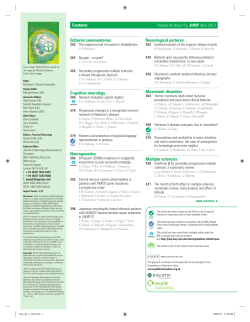
Document 23575
Downloaded from jcp.bmj.com on June 15, 2014 - Published by group.bmj.com J Clin Pathol 1988;41:1025-1029 Letters to the Editor latrogenic prostatic granulomata The exact mechanism by which intravesical BCG causes granulomatous prostatitis is not understood. It may be a systemic effect of BCG, or a result of reflux of urine containing BCG into the prostatic ducts. BCG is being used with increasing frequency in the treatment of superficial bladder cancer.4" Histopathologists must be aware that this treatment is a cause of granulomatous prostatitis when interpreting granulomata in the prostate. 4IN~~~~~~~~~~~ In recent years attention has been drawn to the occurrence of iatrogenic prostatic granulomata after transurethral resection of prostate.'-3 We report three cases of iatrogenic granulomata caused by intravesical instillation of Bacillus CalmetteP RAMANI Guerin (BCG) for flat carcinoma in situ. M GRIFFIN Subsequently two of these patients had tranDepartment of Histopathology, surethial resection for chronic prostatism Bland-Sutton Institute, and one patient had a radical cystectomy The Middlesex Hospital, with prostatectomy for invasive bladder carLondon WIP 7PN. cinoma. Histological examination showed caseating and non-caseating granulomata of varying size. These were composed of aggregates of epitheloid and foreign body giant cells Referems with surrounding lymphocytes and plasma cells. The granulomata were found both in 1 Lee G, Shepherd N. J Clin Pathol 1983;36: the suburothelial connective tissue and in 1067-70. intimate association with the prostatic ducts 2 Ansell ID. Granulomata in bladder and prostate after previous operations (letter). J Clin and acini (figure). Stains for acid fast bacilli Pathol 1984;37:104. were negative in all three cases. 3 Hoboudi NY, Khan MK, Ali HH. Necrotising granulomatous prostatitis after transurethral resection. J Clin Pathol 1984;37:103-4. 4 Kaisary AV. Intravesical BCG therapy in the management of multiple superficial bladder carcinoma. Br J Urol 1987;59:554-558. 5 Anonymous. Bacillus Calmette Guerin in the management of bladder carcinoma [Editorial]. J Urol 1986;2:331-3. Diverticular disease of the right colon Diverticular disease of the left colon is a common condition, but diverticulosis confined to the right colon is rare. I report two cases of the latter that I saw in quick succession. Both were white men who presented in the same way. The first was a 78 year old man who had profuse haemorrhage from the bowel. Diverticular disease of the right colon was diagnosed preoperatively and right hemicolectomy carried out. The second was a 57 year old man who presented with uncontrollable rectal haemorrhage for which a subtotal colectomy was eventually carried out. In this case the cause of the bleeding was not diagnosed preoperatively, but angiodysplasia was suggested. In both resected specimens there were diverticula in the right colon. They were present throughout the hemicolectomy specimen, which measured about 30 cm and were found in the first 30 cm of the subtotal colectomy specimen. Compared with left sided disease, there were comparatively few diverticula in both specimens, and their openings were identified on the mucosal Figure Caseating granuloma seen in the prostate afte and eosin). Downloaded from jcp.bmj.com on June 15, 2014 - Published by group.bmj.com Iatrogenic prostatic granulomata. P Ramani and M Griffin J Clin Pathol 1988 41: 1025 doi: 10.1136/jcp.41.9.1025-a Updated information and services can be found at: http://jcp.bmj.com/content/41/9/1025.1.citation These include: Email alerting service Receive free email alerts when new articles cite this article. Sign up in the box at the top right corner of the online article. Notes To request permissions go to: http://group.bmj.com/group/rights-licensing/permissions To order reprints go to: http://journals.bmj.com/cgi/reprintform To subscribe to BMJ go to: http://group.bmj.com/subscribe/
© Copyright 2025





















